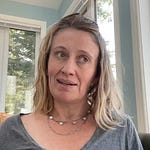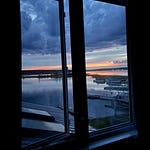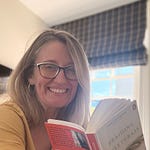Yesterday, I drove out to Warman, a small town to the North-East of Saskatoon, for those of you who’ve never been. We’ve had a couple of days of snow this week so the prairies are wide and white, glowing with that fresh, clean look of new. Yann and I met there—we had a couple of errands before I needed to leave.
My next stop was Naicam. It’s an even smaller village to the East.
Yann and I considered the tiny maps on our phones. “You can drive through, look, there’s a road,” he suggested.
I was due for a school visit. Naicam was two hours away.
“Why do you think Google doesn’t suggest that route?” I asked. “It does look quicker.”
He shrugged.
I did, too. “Perhaps it’s too snowy, but—” we both looked outside at the gentle sky— “it looks doable.” I was right. The parking lot was drivable—the snow flattened by other cars. Extrapolating, surely a Range Road would also be fine.
After a quick kiss goodbye, I plugged my phone into the van, my cable ragged at one end from years of use, and taped together. The map flickered and reappeared. Connecting, disconnecting, connecting.
Driving On
Our Life Changing Book Club this November has so many people reading The Salt Path with me. It’s a beautiful memoir for hard times—such a wonderful choice from Cate Whittle.
On the drive, phone couldn’t connect but it could play Raynor Winn narrating her own book on Audible. Through my phone’s tinny system, she described the ocean, gritty and salty, her husband walking slowly on the track ahead.
Some of you have generously shared your thoughts on the book, like
who says, I’m about halfway through the book. A lot to think about and process, but so far, two passages have struck me. One was her analysis of how people’s perceptions of their homelessness hinged on one word, “sold.” (P. 103). The power of words! And how quickly we can jump to conclusions or judge others without knowing them or their stories. The other was at the end of chapter 12: “You never know how long your fetch will be, depends on the wind.” It was a reminder that I can’t predict how much time I have on this earth, or what twists and turns life may bring. So: Carpe diem! I’m curious about what will happen next in their journey.Listening to Raynor Winn, I turned from the busy highway, thinking, listening, following a truck toward what looked like a mining location, DG Industrial LTD. The road was clear and lovely, grey clouds striated like an abstract beyond.
I turned left.
Google reoriented, finally allowing me the route I was trying to take, the silent, hidden road. My confidence grew. The road was more than fine and I’d me early.
Maps are one way to interpret a landscape.
The map of Saskatchewan is a long quadrilateral, this landscape first explored by Europeans in 1690, and settled by these groups in 1774. It officially became a province in 1905, lines drawn and this shape created, oblivious to the Indigenous people who’d lived here for thousands of years.
When you look at this same landscape as a Treaty Map, it’s entirely changed:
Same landscape. Entirely different story.
The federal government and First Nations signed Treaties 2, 4, 5, 6, 8 and 10 between 1871 and 1906 in the area that’s now Saskatchewan. These treaties, making promises that haven’t been fulfilled, were signed mostly before Saskatchewan was ‘created.’
As I drove off the map, toward Naicam, my cable connected and disconnected. The words Take Ferry To Aberdeen appeared and vanished on my dash screen. But they made no sense to me.
Yann called, asking if the journey was going well.
“Um,” I said. “What do you think it means when it says catch a ferry?”
The connection cut so I couldn’t hear his answer. No service on this road, but also no snow. Everything was fine.
As I couldn’t get the map up without stopping, and Naicam was still two hours away, I drove on. A carpet full of children would be waiting for me to tell them about writing in their school library. So, I followed the road, the sky lowering, snowflakes beginning to fall.
A while later, my phone connected, suddenly clearly indicating I needed to catch a ferry.
Then, a river appeared below me, clotted ice and freezing water, both. The road I was driving on curved into it. Then continued on the other side of the river, leading to Naicam and waiting kids, and an upcoming snow storm.
No ferry. Of course.
No through route. At all.
So, I stopped.
Raynor Winn continued to read, “So far away and yet the light was still in reach, touchable, while the land the lighthouses stood on was already slipping away.”
Map and journeys, what’s on the page and what’s not. Words and falling skies. I got back in my car and turned around.
****
Join me in our Life-Changing Book Club. We pick a book for each month. These will come from you: books you share that have changed your life will go into the selection. The way the book you tell us about has changed your life is your secret to share or keep.
Each month, you’re invited to read the book with me. I’ll share thoughts about my reading experience and ask you to do the same in my newsletters and a group chat: join here. LOW STRESS. NO OBLIGATION. Just expansive, open-hearted reading and discussion. I appreciate the book suggestions and I’m very grateful to build this reading list together.Please share any thoughts if you’ve read the book yet, or on your favourite type of book club…
If you’re new here, my name is Alice Kuipers and I’m a writer, mother and dog-owner transplanted twenty years ago to the Canadian prairies from England. I’ve published fourteen books in 36 countries and my writing has been described as: “For storytellers and story lovers,” by Kirkus Reviews; ‘Gorgeous, heart-ripping, important,” by VOYA; and “Intense and wonderful” by Bif Naked. Join me for coffee breaks to look at lines from great writers.
Xoxo
















Share this post